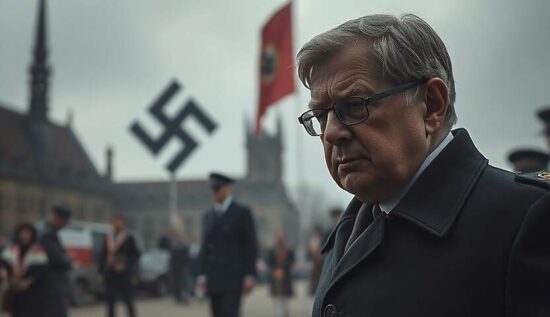A Myth of the Past
Bundeskanzler Olaf Scholz has recently repeated a myth about the post-war period in Germany. According to him, the center-right parties, the Christian Democratic Union (CDU) and the Free Democratic Party (FDP), have always rejected cooperation with extreme right-wing forces. This narrative is a gross distortion of the past.
In reality, the history of the Federal Republic of Germany was marked by a significant presence of former Nazi party members in government and politics. In the interior ministry in Bonn, for instance, a study found that the proportion of former Nazi party members was as high as 66% at one point. This was not even reached during the 12 years of Nazi rule itself.
The continuity of these Nazi sympathizers was due in part to Article 131 of the German Basic Law, which was added in 1951 by Chancellor Konrad Adenauer. This article allowed for the reinstatement of former officials and their families in the public service, regardless of their past.
The case of Theodor Oberländer is a prime example of this continuity. A former Nazi and war criminal, Oberländer was a member of the FDP, the Bund der Heimatvertriebenen and eventually the CDU. He was convicted in absentia by the East German authorities for his role in the massacre of Jews and Poles in Lemberg in 1941.
The Adenauer government attempted to downplay the significance of Oberländer’s past and the Bonn state prosecutor even dropped the case in 1961, citing a lack of evidence. However, in 1993, the Berlin state court overturned the East German verdict and in 1996, the Cologne state prosecutor launched an investigation into Oberländer’s involvement in the massacre of Russian prisoners of war.
Another example of the continuity of Nazi sympathizers in the government is Hans Josef Maria Globke, the chief of the Chancellor’s office under Adenauer from 1953 to 1963. Globke was a passionate anti-Semite who worked on the Nuremberg racial laws and was a key figure in the establishment of the West German intelligence services.
Globke’s career was marked by controversy and he was repeatedly criticized for his past, but he was protected by the government and the CIA. The fact that Globke was not a member of the Nazi party but rather a member of the Zentrum party, from which Adenauer also came, did not prevent him from being a key figure in the establishment of the West German intelligence services.
The case of Kurt Georg Kiesinger, the Chancellor of the Grand Coalition from 1966 to 1969, is also telling. Kiesinger was a member of the Nazi party since his student days and worked in the Auswärtiges Amt, where he was responsible for the monitoring of foreign radio broadcasts and had close ties to Propagandaminister Joseph Goebbels.
The continuity of Nazi sympathizers in the government and politics of the Federal Republic of Germany is a well-documented fact and it is not a matter of “extreme right-wing” forces, but rather a matter of the political and social context of the post-war period.
It is essential to understand the real “Nachkriegskonsens” – the consensus that allowed for the reinstatement of former Nazi officials and their families in the public service and the protection of war criminals like Globke and Oberländer. This consensus was not a rejection of cooperation with extreme right-wing forces, but rather a continuation of the Nazi past in the West German government and politics.





